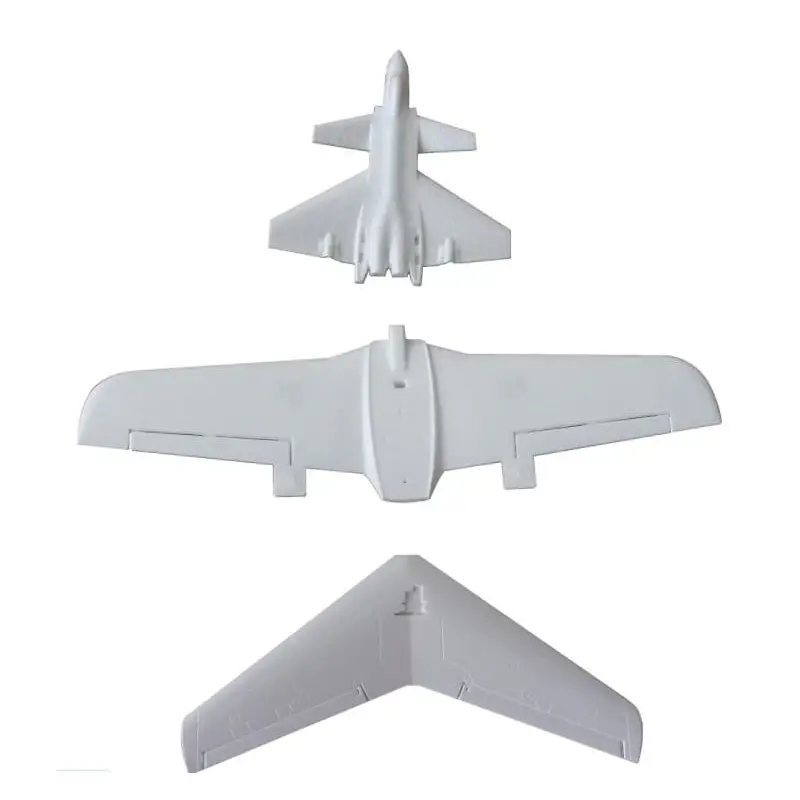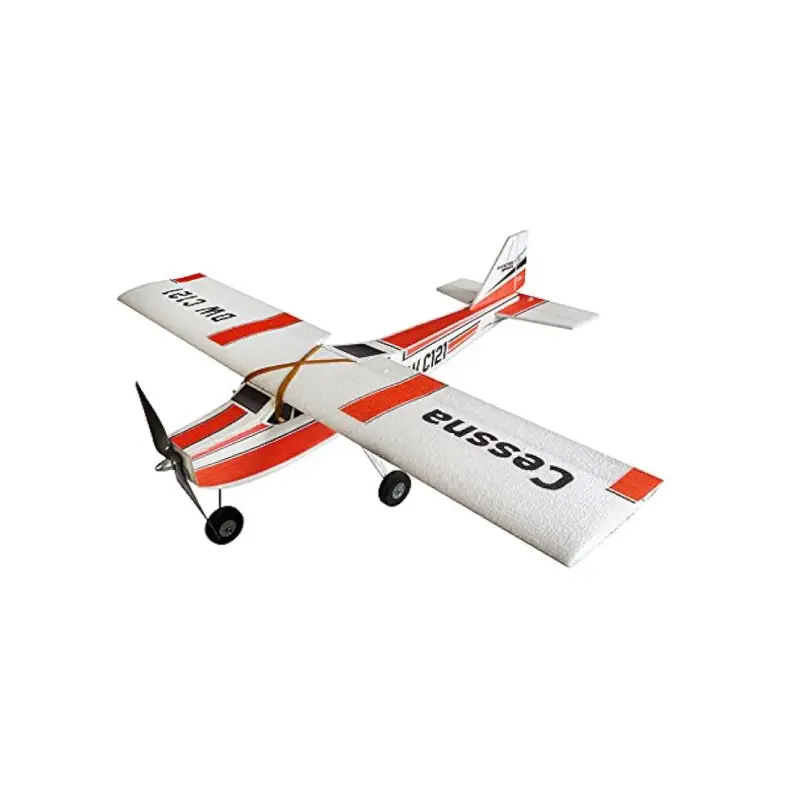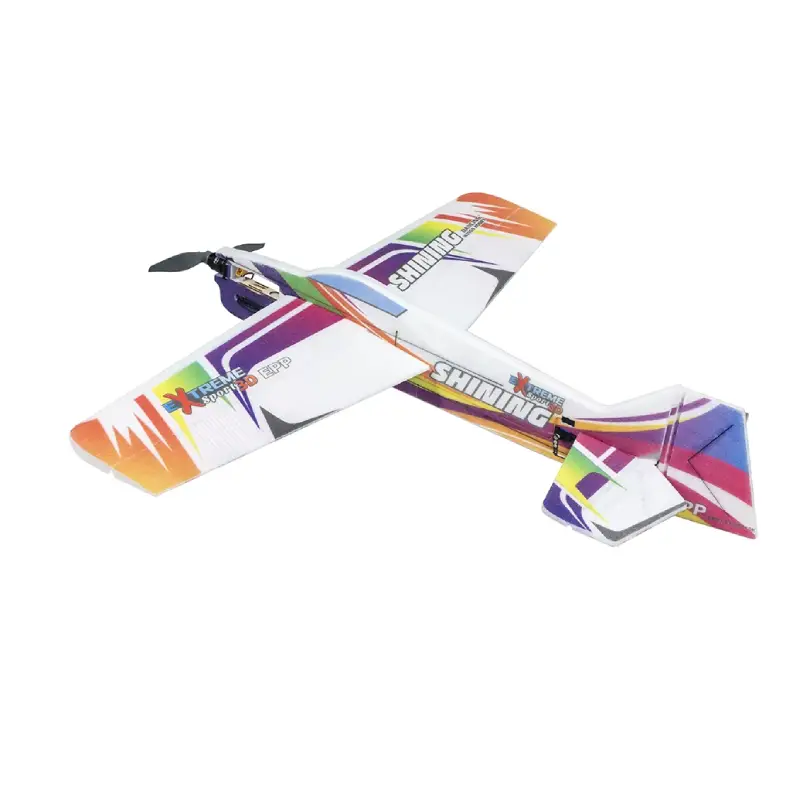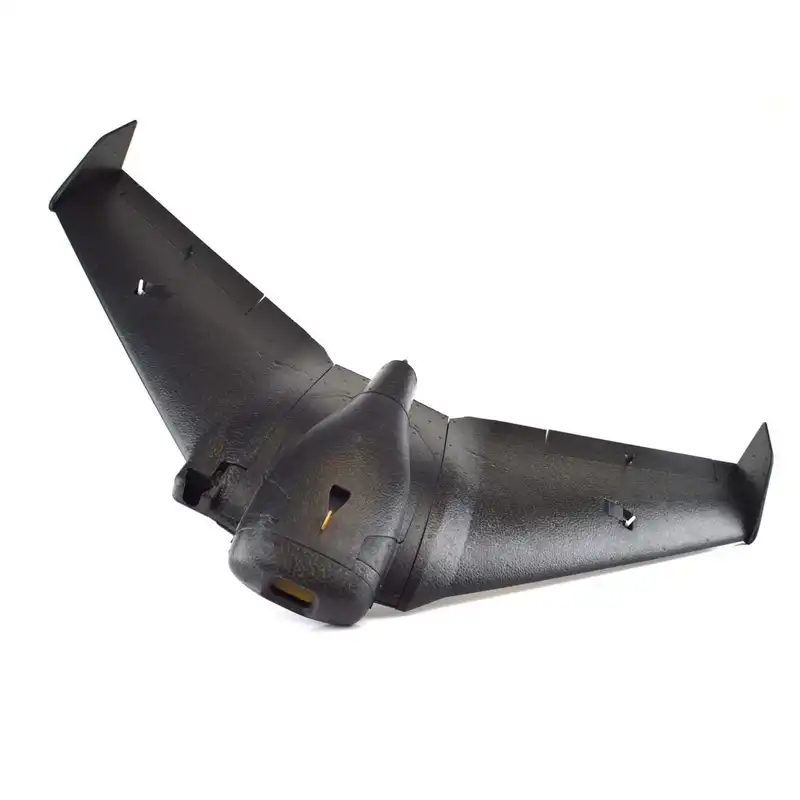
EPP Foam RC Planes
Explore the thrill of flight with our EPP foam RC planes! Engineered for exceptional durability, our lightweight designs deliver agile and prolonged airtime. Even after minor bumps, the easy repairability of EPP ensures you spend more time soaring. Experience stable and forgiving flight characteristics, perfect for pilots of all skill levels. Choose our EPP foam RC planes for lasting fun and reliable performance in the skies.
Get EPP Foam RC Planes Wholesale

Unmatched Crash Resistance: Our EPP foam airplanes are built to withstand the inevitable bumps and crashes of learning to fly or pushing your limits. The flexible yet robust nature of the material absorbs impact energy, minimizing damage and keeping you in the air longer, not in the repair shop.
Featherlight for Superior Flight: The low density of EPP foam results in incredibly lightweight aircraft. This translates to longer flight times on a single battery charge, improved agility and responsiveness in the air, and gentler landings, making them a joy to pilot for everyone from beginners to seasoned flyers.
Quick and Easy Repairs: Accidents happen, but with our EPP foam planes, they don’t mean the end of your flying session. EPP is remarkably easy to repair using common adhesives, allowing you to quickly mend any minor damage and get back to enjoying the skies without significant downtime or specialized tools.
Stable and Forgiving Handling: The inherent properties of EPP foam contribute to exceptionally stable and predictable flight characteristics. Our airplanes are designed to be forgiving, making them easier to control, especially in less-than-ideal conditions. This builds pilot confidence and makes learning the art of RC flight a smoother and more enjoyable experience.

EPP foam 3D RC planes
Experience the exciting world of 3D aerobatics with our EPP foam RC planes! We offer incredibly durable yet lightweight aircraft, engineered for precise control and stunning maneuvers. Their robust EPP construction shrugs off crashes, while easy repairs keep you flying. Enjoy exceptional stability and responsiveness, perfect for mastering advanced 3D skills. Unleash your inner ace with our high-performance EPP foam 3D RC planes!

EPP RC flying wing
Experience the agile and resilient industry of RC flight with our EPP flying wings! Crafted from incredibly durable yet lightweight EPP foam, these wings are built to handle enthusiastic flying and minor mishaps. Enjoy responsive control and stable flight, perfect for carving through the sky. Their simple design makes for quick assembly and easy repairs, ensuring more time soaring and less time tinkering. Discover the pure, unadulterated fun of flying with our EPP RC flying wings!

EPP RC Plane Kits
Embark on your RC aviation journey with our EPP RC plane kits! We provide everything you need to build your durable and lightweight flyer. Experience the resilience of EPP foam, designed to withstand those inevitable learning mishaps. Enjoy extended flight times and agile handling thanks to the lightweight construction. With straightforward assembly and easy repairs, our kits get you into the air quickly and keep you flying longer. Discover the rewarding hobby of RC flight with our user-friendly EPP plane kits!

EPP Foam for RC Planes
We provide EPP foam for RC planes renowned for their exceptional crash resistance, ensuring more flight time and less repair. Their lightweight design delivers superior agility and extended battery life for thrilling aerial maneuvers. Easy, quick repairs keep you soaring without lengthy downtime. Experience stable, forgiving flight – ideal for beginners to advanced pilots. Choose our EPP foam RC planes for durable, high-performance fun in the skies.
What Is RC Plane?
A radio-controlled (RC) plane is a miniature aircraft that is piloted remotely using a transmitter that sends signals to a receiver within the aircraft. This receiver then controls servos, which in turn manipulate the plane’s control surfaces, such as the ailerons, elevator, and rudder, as well as the throttle for the engine or motor. RC planes come in a vast array of sizes, designs, and power types, ranging from small, electric-powered foam models ideal for beginners to large, complex gas-powered aircraft capable of performing intricate aerobatics.
The appeal of RC planes lies in the engaging and hands-on experience of piloting a flying machine from the ground. It offers a taste of aviation without the need for a full-sized aircraft and allows enthusiasts to explore the principles of aerodynamics and flight control in a tangible way. Whether it’s the simple joy of cruising through the sky, the challenge of mastering complex maneuvers, or the satisfaction of building and customizing a model, RC planes provide a captivating hobby for people of all ages and skill levels.
What Is RC Plane used for?
Radio-controlled (RC) planes serve a diverse range of purposes, extending far beyond mere toys. Their versatility and accessibility have made them valuable tools and engaging hobbies for various individuals and organizations. From recreational enjoyment to specialized applications, RC planes offer a unique perspective and practical utility in numerous fields.
Recreational Flying and Hobby: At its core, the most common use of RC planes is for recreational flying and as a fulfilling hobby. Enthusiasts enjoy the challenge of piloting these miniature aircraft, mastering flight techniques, performing aerobatics, and simply experiencing the joy of controlling something in the air. It fosters a sense of accomplishment and provides an engaging outdoor activity for individuals of all ages and skill levels.
Training and Education: RC planes play a significant role in aviation training and education. They provide a safe and cost-effective way for aspiring pilots to learn the fundamentals of flight dynamics, aircraft control, and airspace awareness before transitioning to full-scale aircraft. Simulators and basic RC models allow for hands-on experience with control inputs and the effects of wind and other environmental factors.
Aerial Photography and Videography: The ability to mount cameras on RC planes has revolutionized aerial photography and videography. Drones, a more advanced form of RC aircraft, are widely used to capture stunning aerial views for filmmaking, real estate, surveying, and various other industries. Their maneuverability and relatively low cost compared to traditional aircraft make them invaluable tools for visual data acquisition.
Competition and Sport: RC plane flying has evolved into a competitive sport with various disciplines, including aerobatics, racing, scale modeling, and glider flying. Pilots showcase their skills and the capabilities of their aircraft in organized events, fostering a community of enthusiasts and pushing the boundaries of what’s possible with these miniature flying machines.
Scientific Research and Environmental Monitoring: RC planes, particularly drones, are increasingly being used in scientific research and environmental monitoring. Their ability to access remote or hazardous areas makes them valuable for tasks such as wildlife monitoring, atmospheric data collection, agricultural surveys, and disaster assessment, providing researchers with critical data and insights.
Why Use EPP for RC Planes?
Choosing the right material is crucial in designing effective RC planes, and Expanded Polypropylene (EPP) has emerged as a popular choice for numerous compelling reasons. Its unique combination of properties offers significant advantages that enhance the flying experience, durability, and overall value of RC aircraft, making it a go-to material for both beginners and experienced pilots.
Exceptional Durability and Crash Resistance: One of the primary reasons for using EPP in RC planes is its outstanding durability. Unlike more brittle materials like balsa wood or fiberglass, EPP is highly flexible and can absorb significant impact without breaking. This inherent resilience makes EPP planes incredibly forgiving during crashes, a common occurrence for novice pilots, leading to less damage and more time spent flying rather than repairing.
Lightweight Construction for Optimal Flight: EPP is a lightweight foam, which is a critical factor for achieving good flight performance in RC planes. Lighter aircraft require less power to stay airborne, resulting in longer flight times and improved maneuverability. The low weight also contributes to lower inertia, making the plane more responsive to control inputs and generally easier to handle, especially in windy conditions.
Ease of Repair and Maintenance: Despite its robustness, EPP can occasionally sustain damage. However, repairing EPP foam is remarkably simple and cost-effective. Common adhesives like cyanoacrylate (CA) glue or epoxy readily bond with EPP, allowing for quick and easy fixes. This user-friendly repairability extends the lifespan of the aircraft and reduces the frustration associated with damage.
Excellent Flight Characteristics and Forgiveness: The combination of lightweight construction and a degree of inherent flexibility in EPP contributes to stable and predictable flight characteristics. EPP planes often exhibit a forgiving nature, making them less prone to sudden stalls and easier to control, particularly for beginners. This makes the learning process smoother and more enjoyable, fostering confidence in new pilots.
Cost-Effectiveness and Accessibility: EPP is a relatively cost-effective material compared to some other options used in RC plane construction. This affordability translates to more accessible RC planes for a wider range of enthusiasts. Additionally, EPP is relatively easy to mold into complex shapes, allowing for innovative and aerodynamic designs without excessive manufacturing costs.
What are benefits of EPP RC Planes?
Choosing EPP (Expanded Polypropylene) for RC planes offers a multitude of benefits that cater to pilots of all experience levels. Its unique characteristics translate into a superior flying experience and a more resilient aircraft.
Here are some key advantages of opting for EPP RC planes.
Unrivaled Durability and Impact Absorption: EPP foam stands out for its exceptional ability to withstand crashes and impacts that would severely damage or destroy planes made from more rigid materials. The flexible nature of EPP allows it to absorb significant force, often bouncing back with minimal damage. This inherent toughness is a game-changer, especially for beginners who are more prone to mishaps, reducing repair time and maximizing flying enjoyment.
Ultra-Lightweight for Enhanced Flight Performance: Despite its durability, EPP is remarkably lightweight. This low density is crucial for achieving optimal flight performance. Lighter planes exhibit improved lift and require less power to stay airborne, resulting in longer flight times and more agile handling. The reduced weight also contributes to softer landings and minimizes potential damage upon impact, making for a more forgiving and enjoyable flying experience.
Simple and Cost-Effective Repairs: While EPP’s durability is impressive, occasional damage may occur. Fortunately, repairing EPP foam is incredibly easy and inexpensive. Common adhesives like CA (cyanoacrylate) glue or epoxy readily bond with EPP, allowing for quick and straightforward fixes. This simple repairability extends the lifespan of the RC plane and keeps you flying without the need for complex or costly repairs.
Superior Flight Stability and Forgiveness: The combination of lightweight construction and inherent flexibility in EPP contributes to excellent flight stability and a forgiving nature. EPP RC planes tend to handle wind and turbulence well and are less prone to sudden stalls, making them easier to control, especially for novice pilots. This stability builds confidence and makes learning to fly a smoother and more rewarding experience.
EPP foam vs EPS
Comparing Expanded Polypropylene (EPP) foam and Expanded Polystyrene (EPS) involves understanding their distinct properties and how they cater to different needs in RC planes. While both are lightweight closed-cell foams, their performance characteristics differ significantly, influencing their suitability for various aspects of RC aircraft design and use.
Durability and Impact Resistance: EPP foam reigns supreme when it comes to durability and impact absorption. Its flexible nature allows it to withstand significant crashes with minimal damage, often just bouncing back. EPS, on the other hand, is more rigid and brittle, tending to crack or break upon impact. For RC planes, especially those for beginners or intended for more aggressive flying, EPP’s resilience offers a substantial advantage, leading to less repair time and more flying fun.
Weight and Flight Performance: Both EPP and EPS are lightweight, contributing to good flight performance. However, EPS generally has a lower density than EPP, potentially resulting in slightly lighter airframes. While a lighter plane can offer certain advantages in terms of floatiness and lower power requirements, the added durability of EPP often outweighs this marginal weight difference, especially considering the enhanced longevity and crash survivability it provides for RC models.
Repairability and Cost: Repairing EPP foam is typically easier and more forgiving than repairing EPS. EPP bonds well with common adhesives like CA glue and epoxy, allowing for quick and effective fixes. EPS, when broken, can be more challenging to repair seamlessly. In terms of cost, EPS is generally less expensive to produce than EPP. This can make EPS planes or kits more budget-friendly initially, but the long-term cost of repairs and potential replacements due to damage might favor the more durable EPP option.
Flight Characteristics and Feel: The flexibility of EPP can contribute to a slightly different flight feel compared to the more rigid EPS. EPP planes might exhibit a bit more “give” during flight and in response to control inputs, which some pilots find more forgiving and stable, particularly in turbulent conditions. EPS planes can feel more direct and responsive due to their rigidity, which can be preferred by experienced pilots seeking precise control for aerobatics. Ultimately, the choice between EPP and EPS for RC planes depends on the pilot’s priorities, skill level, and the intended use of the aircraft, with EPP often favored for its superior durability and ease of repair.
